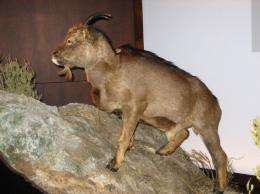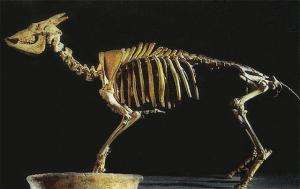November 18, 2009 weblog
Extinct goat was cold-blooded

(PhysOrg.com) -- An extinct goat that lived on a barren Mediterranean island survived for millions of years by reducing in size and by becoming cold-blooded, which has never before been discovered in mammals.
The goat, Myotragus balearicus, lived on what is now Majorca, a Spanish island. The island had scarce resources, and there was no way for the goats to leave, and so scientists wondered how they had thrived for so long. A recently published research paper reveals the extinct goat survived by adjusting its growth rate and metabolism to suit the available food, becoming cold-blooded like reptiles.
Paleontologists studying fossilized Myotragus bones compared them to bones of reptiles living in the same region at the same time, and found surprising similarities. The bones of warm-blooded animals show uninterrupted fast growth, while the bones of cold-blooded animals have parallel growth lines showing interrupted growth corresponding to growth cycles, rather like the rings seen in tree trunks. Growth and metabolism rates are adjusted to suit the amount of food available, whereas warm-blooded animals require food to be available continuously. The Myotragus bones showed the same interrupted growth as reptiles.
Myotragus are the first mammals ever known to have achieved the same flexibility, and hence survivability, as reptiles. They also saved energy by having a brain half the size of hoofed mammals its own size, and its eyes were only a third of the size.

The adult goats stood around 18 inches (45 cm) high, and the kids were around the size of a large rat. Reaching adulthood would have taken many years. Paleobiologist Meike Kohler of the Autonomous University of Barcelona, said the goats would have moved slowly to conserve energy, and probably spent a lot of time lying around basking in the sun. The postcranial skeleton suggested the goat could not jump, run or move fast, which made it easy prey.
Myotragus survived on the island as dwarf cold-blooded animals for millenia because they had no natural enemies, but they could not survive the predation of humans when they arrived on the island about 3,000 years ago. In total, the species inhabited the island for over five million years.
The paper was published online this week in the Proceedings of the National Academy of Sciences.
More information: Physiological and life history strategies of a fossil large mammal in a resource-limited environment, PNAS, Published online before print November 16, 2009, doi: 10.1073/pnas.0813385106
© 2009 PhysOrg.com

















